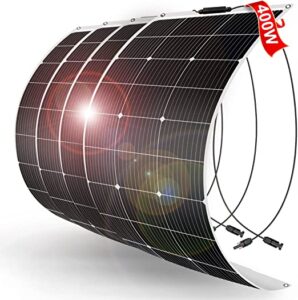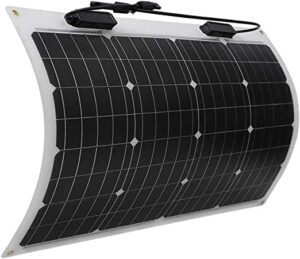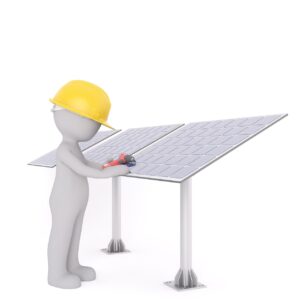Introduction
Alright, folks, let’s dive into a topic that’s as exciting as it is revolutionary. We’re talking about flexible solar panels. Now, before you ask, they’re not yoga practitioners, but they can twist and turn in ways that traditional solar panels never could. Let’s embark on a sunny adventure together.
Understanding Flexible Solar Panels
Diving deeper into the science of flexible solar panels, it’s important to understand how they convert sunlight into electricity. These panels use the photovoltaic effect – where photons (light particles) from the sun strike the thin film of semiconductors, exciting electrons and creating an electric current. In layman’s terms, it’s like having a little sun dance party happening right on your roof!
The Science Behind Flexible Solar Panels
Now for some nerd talk! Flexible solar panels are made of thin-film solar cells. These cells are so thin (we’re talking thinner than a human hair here) that they can be flexed and curved. They are coated onto a flexible substrate material such as plastic, making them pliable. Science, you crazy, right?
Types of Flexible Solar Panels
Monocrystalline
These are the ‘creme de la creme’ of solar panels. Monocrystalline panels are made from a single, pure silicon crystal. Imagine your one true love but for solar energy.
Polycrystalline
Polycrystalline panels are the mosaic artists of the solar world. They’re made from multiple silicon crystals fused together, making them less efficient but more affordable than monocrystalline ones. It’s like a potluck – everyone brings something to the table!
Amorphous Silicon
Now these underdogs don’t get the spotlight but play a crucial role. Amorphous silicon panels have silicon atoms in a random, disorganized formation, leading to lower efficiency but extreme flexibility. They’re the jokers in the pack, bringing surprises when least expected.
Our Recommended Picks
DOKIO Flexible Solar Panels 4x100w(400w)
Experience the power of solar energy like never before with DOKIO’s 4x100W (400W) Flexible Solar Panels. Designed for convenience and durability, these solar panels offer a unique combination of features that make them an excellent choice for all your off-grid power needs.

Lightweight and Easy to Install: Each panel weighs only 2.3 lbs and is just 0.03 inches thin, making them much lighter and thinner than conventional solar panels. The panels are equipped with metal grommet mounting holes, making them easy to install, transport, hang, and remove, providing unmatched convenience.
Extremely Flexible: The DOKIO Flexible Solar Panels can be curved to a maximum 30-degree arc, making them perfect for installation on curved surfaces. Whether it’s roofs, campers, trailers, boats, cabins, sheds, tents, or yachts, these panels adapt to your needs.
High-Quality Material: These solar panels are made using ETFE material, renowned for their superior light transmission and durability. This ensures maximum efficiency and a long lifespan, providing you with a reliable power solution for years to come.
Highly Durable: Built to withstand the toughest conditions, the DOKIO Flexible Solar Panels can endure high wind pressure, snow loads, and extreme temperatures. The component includes a bypass diode and features an input over current protection and reverse protection design, further enhancing its durability and safety.
Harness the sun’s power efficiently and conveniently with DOKIO’s 4x100W (400W) Flexible Solar Panels, a truly versatile and reliable solution for your off-grid power needs. Check out Amazon’s best prices here.
Renogy Flexible Solar Panel 50 Watt 12 Volt
Experience the power of flexibility with the Renogy Flexible Solar Panel 50 Watt 12 Volt. Designed to meet a wide range of applications where standard panels can be challenging to mount, this flexible solar panel is the perfect solution for all your off-grid power needs.

Extremely Flexible: This solar panel can adapt to various surfaces where conventional panels might not be suitable. Whether it’s the curved roof of an airstream or any other irregular surface, this panel fits perfectly, providing efficient solar power wherever you need it.
Ultra Lightweight: Crafted from advanced polymer materials, this solar panel is 70% lighter than conventional solar panels. This significant reduction in weight makes transportation and installation a breeze, ensuring convenience at every step.
Super Thin Lamination: With a height of just a tenth of an inch when laid flat, the Renogy 50W Lightweight Panel is approximately 95% thinner than its rigid counterpart. This makes it virtually unnoticeable and ideal for stealthy solar setups.
Highly Durable: Rigorously tested to withstand the harshest conditions, this solar panel can endure extreme wind of up to 2400 PA and snow loads of up to 5400 PA. This ensures reliable performance regardless of the weather conditions, offering you an uninterrupted power supply.
Potential Uses: The Renogy 50-Watt Flexible Monocrystalline Panel is versatile and can be primarily used in off-grid applications. These include marine, rooftop, RV, boats, and any curvy surfaces, offering you the flexibility to harness solar power in various scenarios.
Harness the sun’s power in the most flexible way possible with the Renogy Flexible Solar Panel 50 Watt 12 Volt – a truly adaptable and reliable solution for your off-grid power needs. Amazon’s prices are hard to beat: take a look here.
Benefits of Flexible Solar Panels
Beyond their lightweight nature and versatility, flexible solar panels offer many benefits. Due to their thin construction, these panels perform better in low light and high heat conditions than traditional panels. It’s like having your own superhero, ready to perform when the conditions get tough.
Also, their adaptability opens up possibilities for creative applications. Have you ever thought of a solar backpack or a solar umbrella? It sounds crazy, but the sky’s the limit with flexible solar panels!
Applications of Flexible Solar Panels
Expanding on their uses, flexible solar panels can also be integrated into the sustainable architecture of buildings, such as windows or facades. Imagine a skyscraper covered in these panels, absorbing sunlight all day long – it’s like a power plant in the form of a building.
They can also be rolled up and used for camping or emergencies. Picture this: you’re out in the woods, your phone’s battery is dead, and you have no power source. Just unroll your solar panel, plug in your phone, and voila – crisis averted!
Installation of Flexible Solar Panels
The installation process usually starts with preparing the surface where you plan to install the panels. This might involve cleaning the surface or applying a special solar panel adhesive. It’s like prepping a canvas before painting, ensuring the masterpiece (in this case, the solar panel) stays in place.
Once the surface is ready, you’ll need to position the panel correctly, considering the sun’s direction. It’s like arranging your beach towel to get the best sun tan!
Step-By-Step Guide
- Prepare the Mounting Surface: The first step to installing your flexible solar panels is to clean and prep the surface where they will be mounted. You can use a simple cleaning solution and a soft cloth to ensure the surface is free of any dust, debris, or oils. Think of it as prepping a canvas before painting. You want it clean and smooth.
- Layout and Positioning: Next, lay your panels on the surface to decide their placement. The ideal placement would maximize sun exposure throughout the day. Think of it as finding the perfect spot on the beach for sunbathing. The more sun, the better.
- Apply Adhesive: After deciding on a placement, apply adhesive to the back of the panels. Most flexible panels come with an adhesive backing, but you may need to apply a separate adhesive for some. It’s like applying a giant sticker, but remember, it’s not repositionable!
- Secure the Panels: Once you’ve stuck the panels onto the surface, you’ll need to secure them. This may involve applying pressure to the panel for a few minutes or using a roller to ensure the adhesive has made full contact with the surface. It’s like pressing down a big temporary tattoo onto the surface.
- Connect the Panels: Now it’s time to connect your panels to your energy system. This step requires careful handling and perhaps a little electrical know-how. Always refer to the manufacturer’s instructions, and don’t hesitate to call a professional when in doubt. It’s like setting up a new gaming console; you want to get it right on the first try.
Tips for Success
- Check Weather Conditions: Try to pick a day with mild weather for installation. Extreme heat or cold could interfere with the adhesive or make handling the panels difficult. Plus, who wants to work under the scorching sun or freezing cold?
- Take Safety Precautions: Safety is always a priority. Make sure to have secure footing if you’re working on a roof, and don’t work alone if possible. And yes, as mentioned before, sunscreen!
- Consider Professional Help: If the installation process seems too daunting or complex, hire a professional. They have the skills and experience to install your panels safely and efficiently. After all, everyone needs a helping hand sometimes.
- Careful with the Wiring: The electrical wiring part of the installation should be done carefully. Mishandling can not only damage the panels but also pose safety risks. It’s like handling a live wire because, well, it is!
- Post-Installation Check: After installation, do a final check. Ensure the panels are secure, the wiring is done right, and there is no debris on the surface of the panels. It’s like buckling up before a car ride; safety first!
Installing flexible solar panels might seem challenging, but with the right preparation and careful execution, it can be a rewarding DIY project.
Maintenance of Flexible Solar Panels
Cleaning
Like any outdoor equipment, flexible solar panels are exposed to the elements, and regular cleaning is crucial to maintain their efficiency. Dust, dirt, or bird droppings can block sunlight and reduce the panels’ performance. Here’s a simple routine you can follow:
- Light Cleaning: Just as you brush your teeth every day, consider gently cleaning your solar panels regularly. Use a soft cloth or a squeegee with a long handle to wipe off any loose dust or dirt. Picture yourself as a window cleaner, but with a more eco-friendly purpose.
- Deep Cleaning: Every now and then, your panels might need a bit of deep cleaning. Mix warm water with mild soap, and gently wash the panels. Rinse them with clean water and let them dry naturally. It’s like giving your panels a well-deserved bubble bath.
- Safety First: Remember, safety is important. If your panels are mounted on a roof or high place, consider hiring a professional cleaner. We all love a clean energy source, but it’s not worth risking a fall!
Checking for Damages
Inspecting your solar panels regularly is key to ensuring they work at their best. Even a small tear can significantly reduce their performance. Think of it as playing detective, looking for any signs of damage or wear and tear:
- Visual Inspection: Every few weeks, visually inspect your panels. Look for any visible damages, such as tears, cracks, or discoloration. It’s like a game of I-spy but with a renewable energy twist.
- Performance Monitoring: Keep an eye on your energy output. If you notice a significant drop in power generation, it could indicate a problem with your panels. It’s like tracking your car’s gas mileage – if it suddenly drops, you know something’s up.
Professional Servicing
Even though maintaining flexible solar panels is relatively easy, consider scheduling a professional service annually. These experts can perform a thorough inspection and identify any potential issues that might not be visible to the untrained eye. Here’s why you should consider it:
- Professional Expertise: Just as you trust a dentist to care for your teeth, professionals have the skills and equipment to ensure your panels are in top shape. They can spot and fix issues before they become bigger problems.
- Safety: Professionals are trained to do the job safely. This is particularly important if your panels are installed in hard-to-reach places like the roof.
- Peace of Mind: With regular professional servicing, you can know that your panels are running efficiently. It’s like having an annual health check-up but for your solar panels.
By keeping these maintenance tips in mind, you can ensure your flexible solar panels stay in top shape and continue to provide you with clean, renewable energy for years to come. After all, a little care goes a long way!
Comparing Traditional and Flexible Solar Panels
While traditional solar panels are still largely prevalent, flexible panels are catching up quickly. Their ability to fit on unconventional surfaces sets them apart. However, they have a lower lifespan and efficiency than traditional panels. It’s a bit like choosing between a sturdy, long-lasting SUV and a sleek, sporty convertible. Both have their perks; it just depends on what you need!
Brands to Look Out For
SunPower
SunPower is one of the leading brands in the flexible solar panel industry. Known for their high-quality, high-efficiency panels, they’re like the Mercedes of the solar world. With regards to their eco-friendly stance, SunPower is committed to sustainability, with a target to achieve 100% renewable energy in their operations by 2025. Their panels are on the higher end of the price spectrum, but they’re worth every penny for the quality.
Renogy
Renogy is another great brand to consider. They’re like the reliable, hard-working Ford trucks of the solar industry. Renogy is also committed to sustainability and reducing its carbon footprint. Their affordable panels make them a good option for those on a budget.
Newpowa
Newpowa offers some of the most budget-friendly flexible solar panels on the market. They’re the economy car of the solar world – not too flashy, but they get the job done. Their commitment to renewable energy is evident in their product line, which includes eco-friendly options for various applications.
In conclusion, SunPower is your go-to if you’re after high efficiency and premium quality. For those looking for a balance between cost and performance, Renogy could be the perfect fit. And if budget is your main concern, Newpowa offers great bang for your buck.
Conclusion
Flexible solar panels, with their numerous benefits and expanding applications, have indeed revolutionized the solar industry. They’ve opened the solar market to new possibilities and made solar energy accessible to everyone, everywhere.
Remember, choosing the right brand, proper installation, and regular maintenance are key to getting the most out of your flexible solar panels. So whether you’re an adventurer needing a portable power source, a homeowner looking to cut down electricity costs, or simply an environmental enthusiast, flexible solar panels can be your slice of the sun.
After all, isn’t it time we bend a little, flex a little, and make the most of what nature offers us so generously?
Frequently Asked Questions
What affects the efficiency of flexible solar panels?
Several factors can impact these panels’ efficiency, including the sun’s angle, temperature, and amount of sunlight. It’s like trying to get a good suntan – you need the right angle, heat, and sun!
Do flexible solar panels work on cloudy days?
Yes, they do. While their efficiency might decrease, they can still produce electricity even on cloudy or overcast days. It’s like having a dimmer switch on your lights – less brightness, but they’re still on.
Can flexible solar panels withstand harsh weather conditions?
Most flexible solar panels are designed to withstand various weather conditions. However, heavy snow or hail could potentially cause damage. It’s like having a raincoat – great for showers but not for a hurricane.
How do I store my flexible solar panels when not in use?
Flexible solar panels should be stored in a cool, dry place away from direct sunlight. If possible, keep them in their original packaging to avoid any potential damage. Think of it like storing a vintage wine – the right conditions are crucial.
Are flexible solar panels as efficient as rigid ones?
While flexible solar panels have improved greatly, they are still not as efficient as traditional, rigid panels. But remember, they make up for it with their versatility and adaptability.





Pingback: Solar Panel Kits: Embrace the Convenience of Solar Power
Pingback: Facts About Solar Energy: Harnessing the Sun's Power
Pingback: Portable Solar Panels: An Anywhere, Anytime Solution - Eco Life Wise
Pingback: Most Efficient Solar Panels: A Comprehensive Guide
Pingback: How Do Solar Panels Work: A Guide for Curious Minds
Pingback: Solar Farms: Harnessing the Power of the Sun - Eco Life Wise
Pingback: Off Grid Solar System: A Step Toward Self Sufficiency
Pingback: Off Grid Trailers: The Ultimate Guide - Eco Life Wise
Pingback: Sustainable Architecture: A Guide to the Future of Design
Pingback: Pros and Cons of Solar Energy: Weighing it Up - Eco Life Wise
Pingback: Solar Water Pump: Sustainable Water Solutions - Eco Life Wise
Pingback: Solar Powered Generator: The Future of Sustainable Energy
Pingback: Self Sustaining Homes: A Definitive Guide to the Exciting Future
Pingback: The Solar Battery: Ensuring A Future of Sustainable Energy
Pingback: The Solar Water Fountain: Top 5 Picks For Your Outdoor Space
Pingback: Off Grid Wind Turbine: Harness the Power of Wind | Eco Life Wise
Pingback: Energy Efficient Homes: Your Ultimate Guide to Greener Living | Eco Life Wise
Pingback: Pros and Cons of Renewable Energy | Eco Life Wise
Pingback: Examples of Natural Resources: Unearthing Earth's Treasures | Eco Life Wise
Pingback: Advantages of Renewable Energy: Embracing a Cleaner Future | Eco Life Wise
Pingback: Charge Your Electric Car With Solar Panels: The Ultimate Guide to Green Energy! | Eco Life Wise
Pingback: Net Zero Revolution: North Carolina Leading the Way | Eco Life Wise
Pingback: How Do Solar Panels Work? | Eco Life Wise
Pingback: Self Sustainable Homes: 7 Practical Reasons Why You Need One Today! | Eco Life Wise
Pingback: Solar Energy Pros and Cons: 8 Considerations | Eco Life Wise
Pingback: What Is A Green Building? | Eco Life Wise
Pingback: Benefits of Renewable Energy: The Future is Bright (and Windy!) | Eco Life Wise
Pingback: Commercial Solar Panels: Exploring the Lifespan | Eco Life Wise
Pingback: How Does Self-Sustaining Architecture Differ From Traditional Architecture? 7 Big Ways | Eco Life Wise
Pingback: Solar Farms: Solar Works NJ Proven Number 1 at Empowering the Future | Eco Life Wise
Pingback: Solar Development on Brownfields and Landfills: 8 Factors That Unlock Value | Eco Life Wise
Pingback: How Do Off-Grid Communities Source Water And Power? | Eco Life Wise
Pingback: How Much Does It Typically Cost To Build A Self-sustaining Home? | Eco Life Wise
Pingback: Salangae Solar Garden Lights Review: 10 New Facts | Eco Life Wise
Pingback: Allto Solar Remote Meter Review | Eco Life Wise
Pingback: Portable Power Station Review: 10 Awesome Tips | Eco Life Wise
Pingback: WYWNA Solar Street Light Review: 10 Amazing Facts | Eco Life Wise
Pingback: Victron Energy SmartSolar MPPT Tr 250V 60 Amp Solar Charge Controller Review | Eco Life Wise
Pingback: Amarine Made Water Pump Review | Eco Life Wise
Pingback: Solar Energy Hope for the Future VHS Review | Eco Life Wise
Pingback: Joomer Solar Christmas Lights Review: 10 Things You Should Know | Eco Life Wise
Pingback: Solar Load Tests: What Are Solar Load Tests? | Eco Life Wise